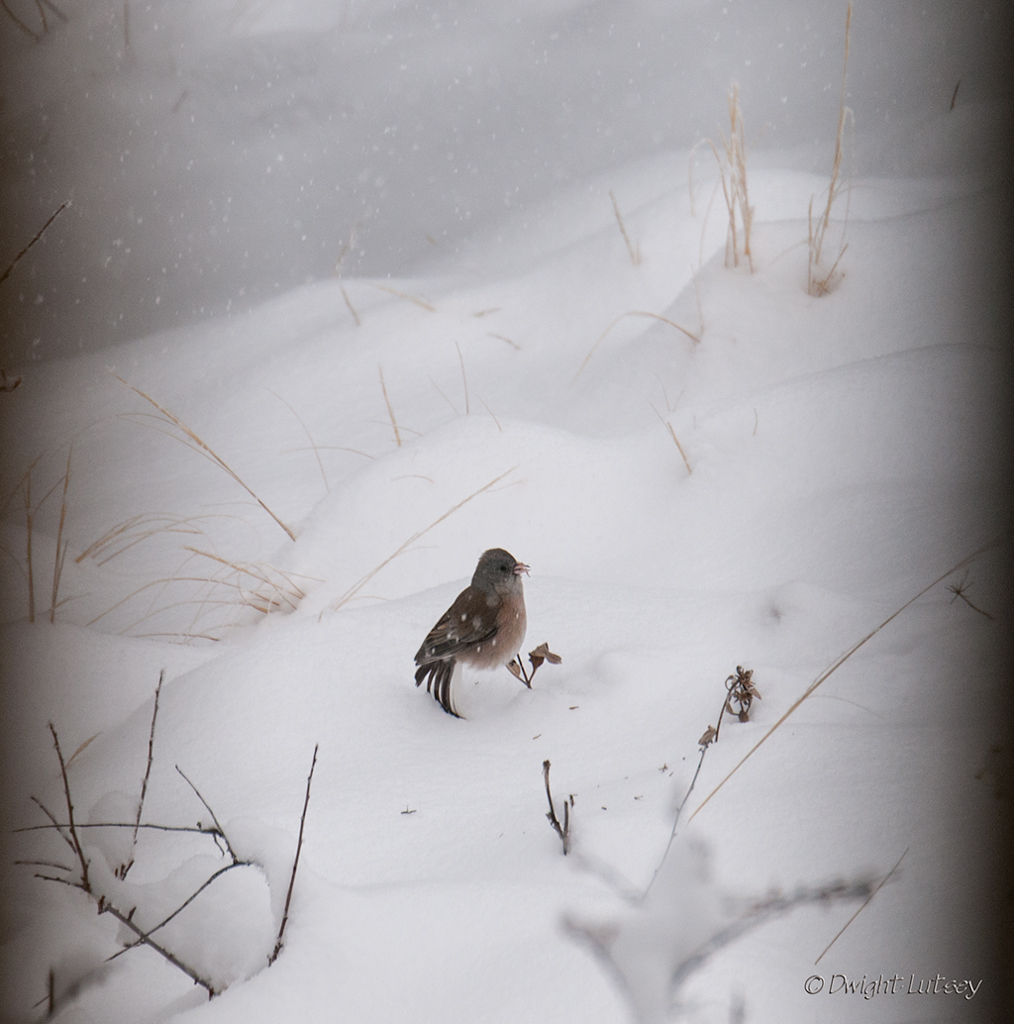 Sparrow Colorado winter Click to enlarge
Sparrow Colorado winter Click to enlarge
The other morning during our 800th snowstorm of the month I heard the faint rustling of tiny wings. Since it was snowing and I was sitting watching it out of the window of the Audubon bird viewing room here at The Institute headquarters, I was unsure of whether it was a bird’s wing I heard or the muted sounds of snowflakes gently careening into each other as they jockeyed for position to land. My spidey senses were at maximum alert as I have found that there is incredible competition between the snowflakes to land in the most picturesque spot for viewing. After all they only get one shot at it and they want it to be perfect.
My visitors that day were a special field crew from the Audubon Society here to use the facility to make a short documentary on how winter birds cope. They were enjoying the 70 year old cognac and the scent of imported Olive wood mixed with the aromatic Pinyon pine burning in the fireplace. Along with the sensation of sitting on 300 year old leather wingbacks from the Hermitage’s Amber room in St. Petersburg they were completely overcome with the creature comforts offered here at the Institute. Most field assignments lack many of these comforts which are de rigueur at the Institute. After all if you’re going to spend the government’s money you should spend it well. Fortunately several years ago the Hermitage was having a yard sale and we were able to pick up a matched set of twelve of these chairs for a steal. One had a small crack in the leather on the armrest but a piece of duct tape fixed that. We also got a really cool tea samovar that was marked down, but that’s a story for another time.
The birds they were seeing outside in the most perfect pristine winter conditions were some of the same birds featured in the Audubon prints in the original Double Elephant collection of the “Havell Edition”. They hang here in the gallery section of the burled-mahogany library now a part of the Audubon bird viewing room. We are fortunate enough to have six complete sets in our collection. With 475 images in each set we often rotate them to keep the gallery fresh. We had seven sets but found that one of our interns had been using them for placemats when she took lunch here in Audubon room. Eating in the Audubon room is strictly prohibited. She is now assigned to our Syrian office.
I don’t mind extending courtesy to the different groups that ask to visit the Audubon room but I insist on proper decorum and these people were nearly out of control with their whisperings and gasping’s of astonishment and constant fidgeting. I was slowly losing patience and was close to sending them packing when this little sparrow that I had heard fly in earlier began posing as if it knew it would soon be seen in HD on big screens everywhere. Apparently realizing its effect on the viewers standing there spellbound it began flitting from one place to another until it found the most exquisite background available and began feeding on the last of seed heads still above the snow.
Now with everyone so quiet you would have thought this was an IRS audit I could finally hear the soft sounds of the snowflakes neatly sifting together to create the white blanket covering the grounds. The sharp crack of each seed being opened as the sparrow went about its work making certain it didn’t miss one kernel, the sound of its feather edges rubbing together as it fluffed up against the cold, and the faint punctuation of the 18th century grandfather clock out in the hallway as it played the final notes of Schubert’s Ave Maria chimes was a counterpoint to everyone’s concentration and made for the perfect balance of watcher and watchee.
I realized that both the sparrow and I had a tough way to make a living. It had to manage the conditions it worked in and so did I. It had to constantly look good, stay fed and healthy, and make sure it got plenty of screen time. Actually the sparrow and I had more in common than I thought

You must be logged in to post a comment.